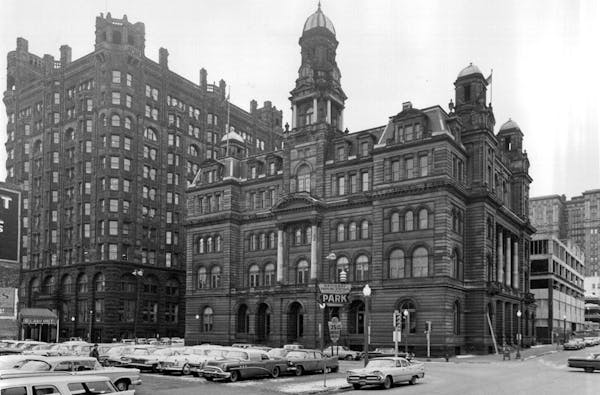One day someone showed the movie. Then the reel went into a case and the case went into a box and the box sat.
Until, one day decades later, it appeared again — on YouTube.
It was a promotional film for Minneapolis from the mid- to late 1960s. In addition to blink-and-you'll-miss-it shots of Minneapolis, it had an earworm song that extolled the city's virtues.
Somehow it ended up at Augsburg University, labeled "Skip Day 1947." (Perhaps it was forgotten for so long because no one wanted to watch postwar undergrad hijinks.)
Stewart Van Cleve, Augsburg's energetic digital archivist, was working his way through the university's old media, digitizing history for the future.
"I opened a drawer, and got a big vinegar whiff," said Van Cleve. That meant the film had spent its time in the dark, decomposing. "The films were stored in old metal tins," Stewart said, "with no ventilation holes — they weren't built for preservation considerations."
A cursory examination of the movie showed it wasn't about Skip Day and wasn't from 1947. It was about Minneapolis, but its date remained a mystery.
Augsburg has its own team that scans and restores films, but this one required special care. It was sent to Home Video Studio in Bloomington, where it was digitized frame-by-frame. The results were delightful.
"The film shows Minneapolis in a snapshot of time," said Van Cleve. "The color footage — to see the color of the buildings, the color of the outfits — it's amazing. It changes your understanding of the times."
The circa 1960s city
It starts with a train ride through the careworn grain district near the University of Minnesota, then heads through Dinkytown. As it crosses the Mississippi River, a cheerful choir sings "Minneapolis! You're so many things to me," just as the city skyline appears.
The song is catchy, which is no surprise: It was written and arranged by Dick Wilson and Ray Charles, the team that gave us "We're Going to Win, Twins."
The film includes many of the same seasonal shots you'd include today: kids fishing off a bridge (possibly in Loring Park) in summer; parade beauties waving with gloved hands; a sailboat on a lake; Minnehaha Falls.
A second later, we're looking at skiers schussing down a hill and the choir sings: "The crisp, cold days of winter, with trees hung full of snow."
It continues through the seasons, and around the city. There's a glimpse of Hennepin Avenue, a shot of a skyway (there weren't many at the time), the old Guthrie.
It's three minutes long.
Van Cleve decided to post the film on YouTube, giving it a "circa 1965" date.
The film proved surprisingly popular, with more than 20,000 views. And for some, it proved to be a challenge to determine the date the film was made.
A thread on Reddit tried to nail down the year.
One sleuth noted that a brief clip of the Twins showed "a lefthander hitting #11 grounding to second base in the Twins clip," said Reddit user DavidRFZ. "The first lefty to wear #11 was Bernie Allen in 1966 and then Ted Uhlaender from 1967-69."
Another sleuth studied a quick pan across Hennepin Avenue. The shot includes the Mann Theater, the Gopher Theatre and, for a nanosecond, you see the marquee for the Lyric Theatre, with "John Wayne" and "Green Berets."
That movie played the Lyric in 1968, which means the lefty #11 was likely Ted Uhlaender. And "circa 1965" date for the Minneapolis film becomes 1968.
Ted's gone. The Lyric is gone, torn down for the charmless Skyway Theatre. The Gopher made way for City Center's parking ramp. The Mann survives, though — known by its old name, the Pantages.
A snippet of history
The film also has a quick shot of the Nicollet Mall and a bus crossing it, wearing the old livery: green.
You'd probably be considered an old-timer if you remember when the buses were red. Green goes way back. The bus in the film has an advertisement for Gold Bond on the side. It's referring to the trading stamps, not the foot powder.
Since the film was shot, Nicollet Mall has been redone, three times. The buses are white now. Trading stamps aren't around, but the Gold Bond Stamp firm turned into Carlson, which gave us the Radisson Hotel chain.
Early in the film there's a brief glimpse of some modern streetlights — round white balls on poles. You might be able to find those somewhere around the city. And the lake with the sailboat might have changed its name (and changed it back again), but it's still here. The Guthrie's moved, but the Guthrie's still here.
Augsburg's Van Cleve is continuing the university's restoration project.
"There are two key reasons we've pursued this restoration aggressively," he said. "Augsburg is celebrating its 150th anniversary next academic year, but also because Augsburg has been a part of Minneapolis since 1872.
"A lot of the footage we have shot shows the surrounding neighborhood, and a homecoming parade down Nicollet Avenue in 1950 in color. You can see the Nicollet Hotel peeking out, all these floats. We have another piece that's really interesting — it shows Riverside Avenue, a corner store, and a yellow stop sign, which I've never seen before."
In other words, there's more footage to come from Augsburg's project. Not all of the footage they fix and reveal will have a chipper song, but it will likely show a city that, while different, is unmistakably our city.




![Allianz Field was photographed Wednesday, April 3, 2019 in St. Paul, Minn. ] Aaron Lavinsky • aaron.lavinsky@startribune.com Allianz Field was](https://arc.stimg.co/startribunemedia/4PQE3RT6WX2JJMOGN5E42P5HMQ.jpg?w=600&h=600&auto=format%2Ccompress&cs=tinysrgb)